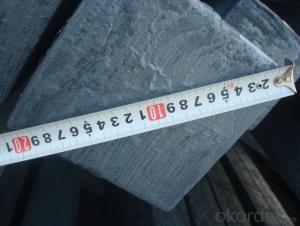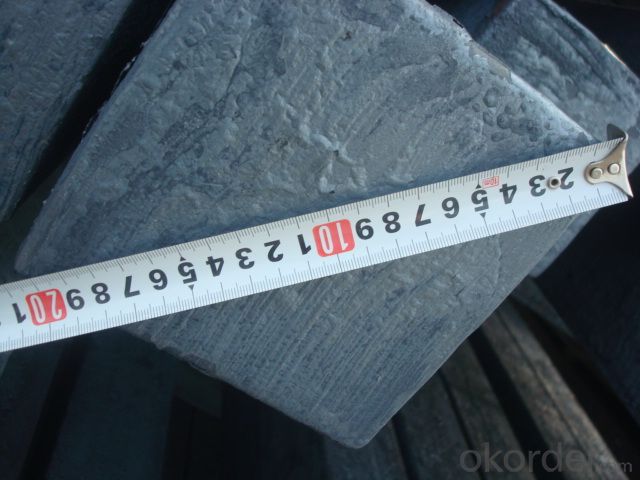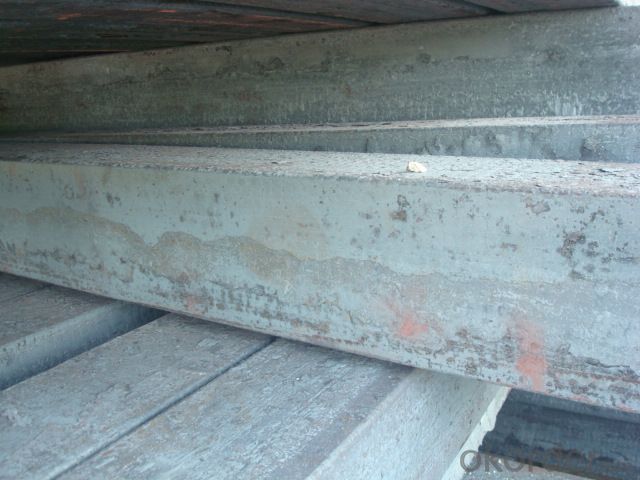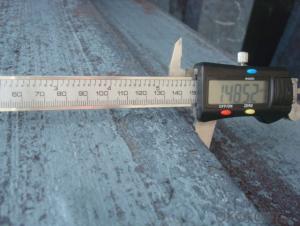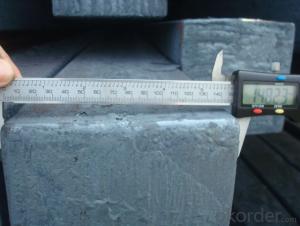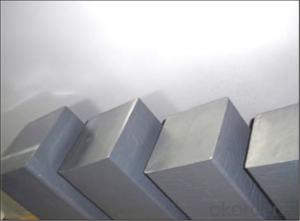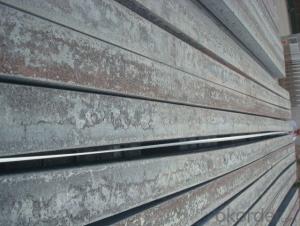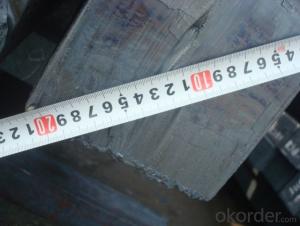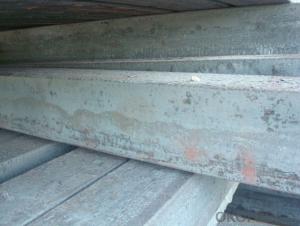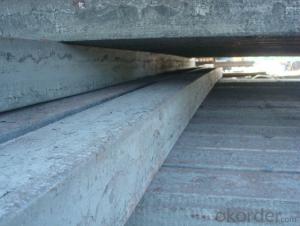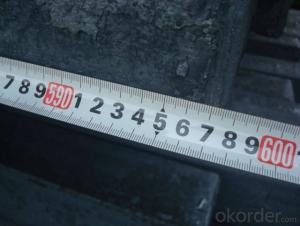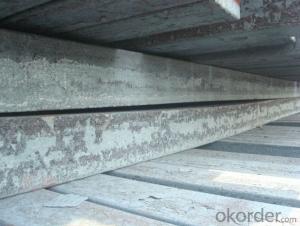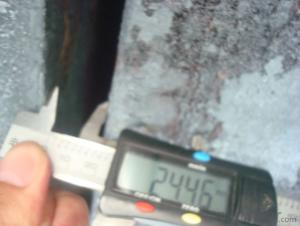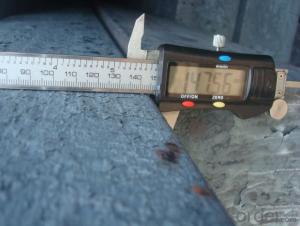Continue Casting Steel Bloom Manufactured by Blast Furnace
- Loading Port:
- Tianjin
- Payment Terms:
- TT OR LC
- Min Order Qty:
- 10000 m.t.
- Supply Capability:
- 100000 m.t./month
OKorder Service Pledge
OKorder Financial Service
You Might Also Like
Continue Casting Steel Bloom Manufactured by Blast Furnace
1.Structure of Continue Casting Steel Bloom Manufactured by Blast Furnace
Continue Casting Steel Bloom Manufactured by Blast Furnace After casting billet is ingot steel products.Mainly from the manufacturing process of billet can be divided into two kinds: die casting billet, slab and the die casting process has been basically eliminated
2.Main Features of Continue Casting Steel Bloom Manufactured by Blast Furnace.
(1) the billet: cross section width and height are equal, or the difference is not big, is mainly used to rolling profile, strip, wire screw, etc.Such as working Angle channel steel, strip steel, line 145, etc.
(2) the slab: cross section width and height of the ratio of the larger, mainly used for rolling plate.Such as hot rolled coils, cold rolled coil plate, plate, etc.
3. Continue Casting Steel Bloom Manufactured by Blast Furnace Images
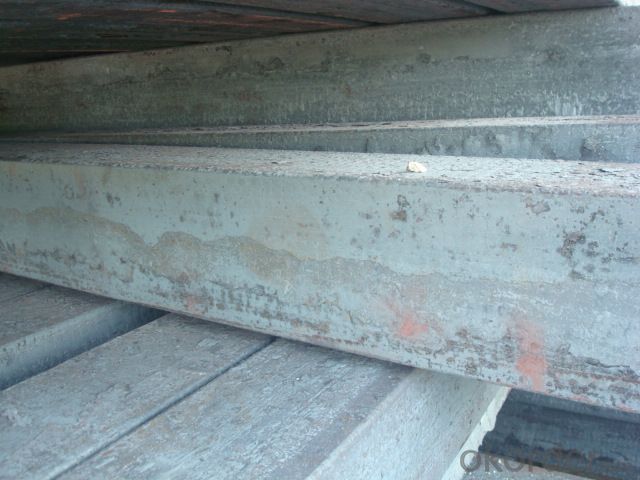
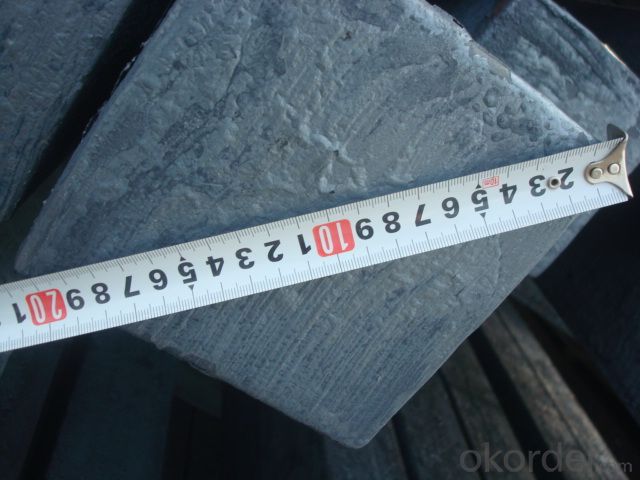
4. Continue Casting Steel Bloom Manufactured by Blast Furnace Specification
Continue Casting Steel Bloom Manufactured by Blast Furnace rolled steel, after processing can be used for mechanical parts, forging parts, processing all kinds of steel, steel Q345B channel steel, wire rod is the role of the billet. Steel billet is used in the production of semi-finished products, generally cannot be used directly for the society. Steel billets and steel are strictly divided into standard, cannot decide to whether the business enterprise of the final product, and according to unified standards to perform the whole society. Typically, billet and the steel is relatively easy to distinguish, but for some steel billet, and have the same specification and same steel purposes (such as rolling tube billet), whether can be used for other industries, whether through steel processing process, whether through a finished product rolling mill processing to distinguish
The chemical composition of steel billet according to the steel classification:The alloy steel billet,Low alloy steel billet,Alloy steel billet.Steel grade are:General carbon steel,High quality carbon structural steel, high strength low alloy structural steel, high quality ribbed reinforced with steel,Machine with hot rolled deformed steel,With hull structureSteel, alloy structural steel, welding wire steel, spring steel, mine steel, cold heading steel, boiler with carbon and alloy steel, pressure vesselSteel, seamless steel cylinders, light rail steel, automobile girder Bridges with steel, steel, welding steel, pipeline steel, container plate steel, corrosion resistanceSteel and steel composite substrate23A series of180More than
5.FAQ of Continue Casting Steel Bloom Manufactured by Blast Furnace
We have organized several common questions for our clients,may help you sincerely:
①Where is your factory's location?
Mainly in the north of China, including Hebei and Tianjin.
②If we want to visit the factory and get some samples, is that ok?
Sure, but you have to tell us in advanced to arrange the cutting machine for you.
③If the result of the inspection not ok, could we return the cargo?
Sure.
- Q: What are the common defects in steel billets during hot rolling?
- Certain defects may be experienced by steel billets during hot rolling, which could potentially impact the quality of the final product. Some commonly encountered defects include: 1. Longitudinal surface cracks: These cracks appear on the surface of the billet and may occur due to inadequate cooling, high rolling temperatures, or inferior steel quality. Surface cracks can compromise the structural integrity and performance of the product. 2. Internal cracks: These cracks are found within the billet, away from the surface. They can be caused by insufficient billet heating, uneven temperature distribution, or improper rolling parameters. Internal cracks may lead to material failure or inconsistencies in the final product's dimensions. 3. Surface defects: These defects encompass scales, pits, or scars on the surface of the billet. They are often a consequence of subpar billet preparation, inadequate scale removal, or improper rolling techniques. Surface defects can impact the appearance and surface quality of the final product. 4. Lamination: Lamination defects manifest when there are layers or separations within the billet. They can be caused by impurities in the steel, improper billet preparation, or inadequate rolling parameters. Laminations can result in diminished mechanical properties and compromised structural integrity of the final product. 5. Warping: Warping defects occur when the billet experiences uneven cooling or excessive rolling tensions. This can cause distortion or bending of the billet, leading to inconsistencies in the final product's dimensions. 6. Inclusions: Inclusions refer to non-metallic particles or impurities that become trapped within the steel during the billet formation process. They can lead to reduced mechanical properties, surface defects, or material failure in the final product. To mitigate these defects, it is crucial to exercise proper control over rolling parameters, billet preparation, and cooling processes. Regular inspections and the implementation of quality control measures should be employed to detect and address any defects that may arise during hot rolling.
- Q: How long do steel billets last?
- The longevity of steel billets varies depending on multiple factors, including their storage conditions and utilization. Provided that they are stored appropriately in a controlled environment with low humidity and shielded from corrosion, steel billets can endure indefinitely. Conversely, if they are exposed to harsh weather, excessive moisture, or corrosive substances, their lifespan can be significantly diminished. As for their usage, steel billets are typically melted and transformed into other steel products, such as bars, rods, and beams. The lifespan of the final product hinges on its specific application and the maintenance practices implemented. Generally, steel products are renowned for their durability and longevity, rendering them a dependable option in numerous industries.
- Q: How are steel billets used in the manufacturing of industrial pumps?
- Steel billets are used in the manufacturing of industrial pumps as raw material for forging the critical components such as impellers, casings, and shafts. These billets are heated and then shaped through various processes like rolling, extrusion, or hammering to create the desired pump parts that exhibit high strength, durability, and resistance to corrosion and wear.
- Q: How are steel billets used in the production of steel cables?
- Steel billets are used in the production of steel cables by being heated and then passed through a series of rollers to shape them into thin, long strands. These strands are then twisted together to form the cables, which are used for various applications such as suspension bridges, elevators, and construction projects. The high strength and durability of steel billets make them ideal for producing strong and reliable steel cables.
- Q: What is the role of steel billets in the manufacturing of agricultural machinery?
- Steel billets play a crucial role in the manufacturing process of agricultural machinery. These billets are essentially semi-finished steel products that are typically cast into a rectangular shape. They serve as the raw material for various components and parts of agricultural machinery. The use of steel billets provides several advantages in the manufacturing of agricultural machinery. Firstly, steel is known for its exceptional strength and durability, making it an ideal material for heavy-duty machinery that is subjected to harsh operating conditions. Steel billets, being the starting point of the manufacturing process, ensure that the final products possess the necessary strength and durability to withstand the demands of agricultural activities. Moreover, steel billets offer versatility in design and fabrication. Agricultural machinery requires a wide range of components with different shapes and sizes, and steel billets can be easily molded and machined to meet these requirements. This flexibility allows manufacturers to produce complex parts that are essential for the efficient operation of agricultural machinery. Additionally, steel billets provide consistent and reliable quality. The manufacturing process of steel billets involves strict quality control measures to ensure uniformity and adherence to industry standards. This consistency in quality translates into reliable performance and longevity of the agricultural machinery, reducing the need for frequent repairs or replacements. Furthermore, steel billets have excellent resistance to corrosion and wear, which is crucial for agricultural machinery exposed to various environmental elements. The use of steel billets ensures that the final products can withstand exposure to moisture, chemicals, and abrasive materials commonly encountered in agricultural settings. In summary, steel billets are integral to the manufacturing of agricultural machinery due to their strength, durability, versatility, consistent quality, and resistance to corrosion and wear. By using steel billets as the raw material, manufacturers can produce agricultural machinery that meets the demanding requirements of the agricultural industry, ensuring reliable and efficient performance in various farming applications.
- Q: How are steel billets used in the production of oil and gas components?
- Due to their strength, durability, and ability to withstand extreme conditions, steel billets are indispensable in the production of oil and gas components. These billets serve as essential raw materials in various manufacturing processes for creating the equipment and parts required in the oil and gas industry. One notable application of steel billets in the oil and gas sector is their use in manufacturing pipes and casings. These billets are heated and then rolled or forged into seamless or welded pipes, which are utilized for transporting oil and gas from wells to refineries or distribution centers. The high strength of steel billets ensures that these pipes can endure the high pressure and corrosive nature of the substances being transported. Steel billets are also integral to the production of valves, flanges, and fittings, which are critical components in oil and gas infrastructure. These billets are machined or forged into various shapes and sizes to create these components, used for controlling the flow of oil and gas within pipelines or at different stages of the production process. The durability and resistance to corrosion of steel billets make them ideal for these applications, as they can endure the harsh conditions often encountered in oil and gas operations. Moreover, steel billets find utility in the production of drilling equipment such as drill bits, drill collars, and drill pipes. These billets are frequently treated with heat or alloying elements to enhance their strength and wear resistance. The resulting components can withstand the intense forces and abrasion experienced during drilling operations, ensuring efficient and reliable extraction of oil and gas reserves. In conclusion, steel billets play a crucial role in the oil and gas industry by providing the essential raw materials for manufacturing durable and high-performance components. Their strength, durability, and resistance to corrosion make them an ideal choice for the challenging conditions encountered in the production, transportation, and processing of oil and gas.
- Q: What are the main factors affecting the hardenability of alloy steel billets?
- The main factors affecting the hardenability of alloy steel billets include the chemical composition of the alloy, the grain size and distribution, the cooling rate during heat treatment, and the presence of alloying elements such as carbon, manganese, chromium, and molybdenum. These factors determine the ability of the steel to form and retain a hardened structure, thus affecting its overall hardness and strength properties.
- Q: Refinery carbon 3 is propane, then carbon four carbon five is what name ah?.What are they used for?
- Carbon four is butane, C4H10 carbon five is pentane C5H12
- Q: How are steel billets used in the manufacturing of power transmission equipment?
- Steel billets are used in the manufacturing of power transmission equipment as they serve as the raw material for various components such as gears, shafts, and housings. These billets are forged, machined, and shaped into the required sizes and shapes to create strong and durable parts that can withstand the high loads and pressures involved in power transmission. Overall, steel billets play a vital role in ensuring the reliability and performance of power transmission equipment.
- Q: What are the different methods of surface cleaning for steel billets?
- There are several methods of surface cleaning for steel billets, each with its own advantages and uses. 1. Shot Blasting: This method involves propelling abrasive particles, such as steel shots or grits, at high speeds onto the surface of the billets. Shot blasting effectively removes rust, mill scale, and other contaminants, leaving a clean and roughened surface. This process is commonly used for preparing the billets for further processing, such as painting or coating. 2. Acid Pickling: Acid pickling is a chemical method that involves immersing the billets in a bath of acid, typically hydrochloric or sulfuric acid. The acid reacts with the surface oxides and scale, dissolving them and leaving a clean surface. Acid pickling can remove a wide range of contaminants, but it may also cause hydrogen embrittlement if not properly controlled. 3. Mechanical Cleaning: Mechanical cleaning methods involve the use of abrasive tools or equipment to physically scrub or scrape the surface of the billets. Wire brushes, abrasive pads, or sandpaper can be used to remove loose rust, scale, and dirt. This method is suitable for small-scale cleaning or localized areas but may be time-consuming for larger surfaces. 4. Water Jetting: Water jetting or high-pressure water cleaning utilizes a high-pressure water stream to remove dirt, rust, and other contaminants from the surface of the billets. The force of the water effectively removes loose debris without damaging the underlying steel. Water jetting is an environmentally friendly method that does not involve chemicals and is commonly used for light cleaning or maintenance purposes. 5. Chemical Cleaning: Chemical cleaning involves the use of specialized chemicals or solutions to dissolve or neutralize contaminants on the surface of the billets. This method can be effective in removing stubborn stains, oils, or specific types of corrosion. However, it requires careful selection and handling of chemicals to avoid any adverse effects on the steel or the environment. 6. Electrochemical Cleaning: Electrochemical cleaning, also known as electrolytic cleaning or electrocleaning, utilizes an electric current to remove surface contaminants. The billets are immersed in an electrolyte solution, and the application of an electric current causes the contaminants to be dissolved or deposited onto an electrode. This method can be particularly effective for removing organic contaminants or for precision cleaning. Each of these methods has its own advantages and limitations, and the choice of the appropriate surface cleaning method for steel billets depends on factors such as the type and severity of the contamination, the desired surface finish, and the specific requirements of the subsequent processes.
Send your message to us
Continue Casting Steel Bloom Manufactured by Blast Furnace
- Loading Port:
- Tianjin
- Payment Terms:
- TT OR LC
- Min Order Qty:
- 10000 m.t.
- Supply Capability:
- 100000 m.t./month
OKorder Service Pledge
OKorder Financial Service
Similar products
Hot products
Hot Searches
Related keywords
